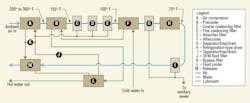A Fresh Look at Compressed Air
Buying a plant air compressor is a capital expenditure. Typically, the plant engineer determines his current compressed air requirement based on if all pneumatic devices in the shop were to run at once, adds a safety factor, guesses how much additional capacity he might need in the near future, and converts the total scfm into horsepower. He then gives that number to the purchasing department and they look for the lowest quotation on a compressor of that size from three local distributors. (As an aside: even though the air compressor usually is installed in a room where it will be seen only by a few disinterested maintenance workers, it is not unheard of for a purchasing department to select a unit on the basis of horsepower, price, and appearance.)
As a 30-year veteran of the air compressor wars, I believe that the technical specification must be expanded and refined to truly define the best compressor for the plant in today's industrial environment. I believe the specifier should ask:
- Which design is most efficient?
- What about electric motor efficiency (and future rate increases)?
- What about lubricant usage?
- What about cooling water cost (and future rate increases)?
- What about wastewater disposal cost (and future rate increases)?
- Does the system meet noise regulations?
- What about the quality of the compressed air that will be delivered to the plant's system?
I have asked and answered all those questions myself while I developed the Ecology Package Technology. This package addresses and deals with all the heat and contamination issues that inhibit the performance of any air compressor. The technology solves problems that all existing air-compressor systems have — using components they need, but do not have.
Look for energy efficiency
The most energy-efficient way to run an air compressor is in the full-load/no-load mode, but when unloaded, the electric motor's power factor typically drops significantly. (Synchronous electric motors offer the highest power factor, but they have become cost-prohibitive for most applications. Variable-speed drives also are too expensive.) Power-factor-correcting capacitors improve the efficiency of standard motors. They should be selected to correct both loaded and unloaded conditions. Power factor (PF) correction is part of the Ecology Package — producing a 95% PF at full and no load. Stofen has figures to prove that such a conversion pays for itself in utility savings in about nine months.
Studies show that today's oil-flooded, rotary-screw-type compressor with non-symmetrical rotors has become the most efficient basic design. Ideally, the compressor should have an oil pump to provide lubrication at startup; provide lubrication when the compressor is unloaded; and prevent over-flooding of the compression chamber at full load. Such compressors are readily available in the 50- to 300-hp sizes found in most plants.
(Note that the concepts and components in the Ecology Package still will improve the performance of other compressor designs, even as retrofits. Properly designed components can eliminate all of the problems caused by excessive moisture in new and used air compressor systems.)
It has long been almost an axiom that large air compressors should be water-cooled — because industrial air-cooled units have a reputation for getting dirty, overheating, and then shutting down while heat soak ruins the lubricant. Air-to-air heat exchangers can become coated with airborne oil aerosols from the ambient air. Dust then settles on the oil coating to form an insulation layer that restricts heat rejection and can cause overheating. Timely maintenance will prevent this, but compressor maintenance often is the orphan of shop scheduling. When the cost issues of cooling water and its disposal are considered, the value of air cooling and importance of maintenance becomes clear — and economically necessary.
The right lubricant
Selecting a compressor lubricant formulated for long life under high-temperature operating conditions will extend the time between expensive oil changes. From the top ten synthetic lubricants in an air-compressor lubricant test, Stofen selected the synthetic fluid (not synthetic oil) that had the highest overall rating for use in the Ecology Package. This brand formulates one fluid for screw-type compressors and another for reciprocating types. Obviously, it is bad practice to mix different types of lubricating fluids.
Keep in mind that all the ambient air that passes through air compressor's intake filter goes directly into the lubricating fluid that floods the screws in the compression chamber of the air end. This makes the compression chamber an oil-bath air cleaner, and it does a great job on the incoming air. This is good for the air but challenging for the lubricant. Because of this, a properly sized bypass filter to augment the full-flow fluid filter installed at the factory. Flow from the bottom of the compressor's oil/air separator is preferentially directed to the 10-µm full-flow filter; excess oil is directed to the 1-µm bypass section. All the lubricant in the compressor cycles through the filter approximately every 15 minutes. This arrangement removes solid particles down to less than one micron. Clean, cooled lubricant enters the suction side of the oil pump.
Tests have shown that solid particles in the 5- to 25-µm size range cause most wear on moving parts. Therefore, there is virtually no wear on the compressor's moving parts from the 1-µm particles remaining in the lubricant — and thus no need to change it as frequently as many compressor manufacturers suggest. The lubricant in my demonstration model is analyzed every six months as a precaution. The two-year analysis came back with this notation: "No corrective action required, oil is suitable for continued use. Resample at next regular interval."
Managing air temperature
Compressed air exiting any compressor is hot, wet, and oily. The temperature of the exiting air ranges from 200° to 365° F. The air still carries all the water vapor it carried as ambient air (but now packed into a smaller volume), and it has picked up oil aerosols while passing through the compressor. The Ecology Package passes the air through a precooler that drops its temperature to 155° F — then through two coalescing filters and an adsorber filter. The precooler (my all-copper design is water cooled) is thermostatically controlled to keep it warm enough so the water does not precipitate out of the compressed air, but not so hot that it will damage parts of the downstream filters. The water remains a vapor that passes right through the coalescing and adsorber filters while they remove other airborne contaminants — including oil mist and oil vapor.
(The aluminum filter bowls cool off when the system is shut down. The small volume of oily water that condenses in the bowls drains automatically and is piped back to the air compressor. There, it is heated to between 180° and 200° F to vaporize again. Eventually the aftercooler and dryer's evaporator downstream removes it.)
Compressed air leaving the adsorbing filter is clean but still saturated with water vapor. Passing that air through the aftercooler drops its temperature to 100° F or less, and any water precipitates out as a clear condensate. The condensation process removes the few remaining oil aerosols by nucleation. Because this concentration is so low, it can be drained to a sanitary sewer without the need for the downstream oil-water separator.
Maximizing dryer performance
The 100° F compressed air now can flow through a refrigeration-type dryer that will lower its pressure dew point so water vapor will not condense out under any of the downstream temperatures it will see. Because the air is truly at the 100° F inlet temperature recommended by CAGI, and is clean and practically oil-free, dryer efficiency and performance will remain at a high level.
Management of the heat removed from the lubricant and the compressed air is another aspect of the Ecology Package. Cold tap water is directed into the aftercooler, then through the precooler, and finally to the fluid cooler. The warmed water from the fluid cooler now is available for in-plant processes or can be sent to the sanitary sewer.
In another circuit, hot (200° to 365° F) lubricant from the compressor's pump flows to the reheater, where it raises the temperature of the compressed air leaving the dryer (to about 160° F on screw-type air compressors). The heated compressed air expands — effectively increasing its volume to conserve energy. The temperature of the synthetic fluid drops considerably when it passes through the reheater, making it easier for the fluid cooler to cool it to the desired temperature to return to the oil pump. By filtering the fluid and controlling its temperature, there is no reason why the lubricating fluid in the air compressor should not replicate the service life of the lubricating oil in a household refrigerator.
Contact Ken Stofen at [email protected] to discuss how Ecology Package Technology can be applied to your air-compressor installation.


